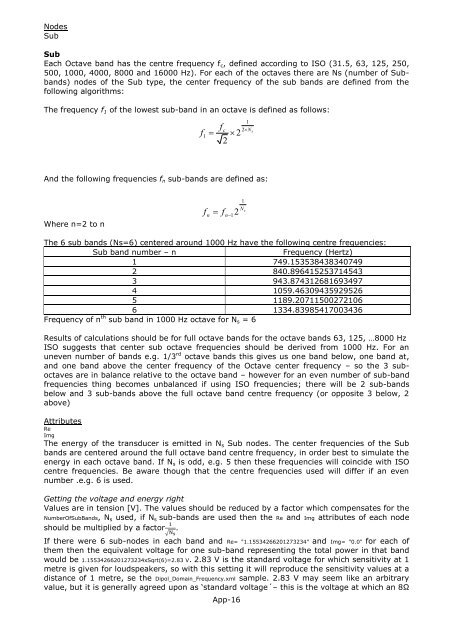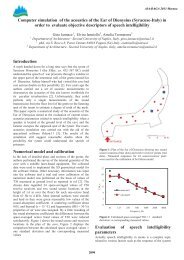Download - Odeon
Download - Odeon
Download - Odeon
You also want an ePaper? Increase the reach of your titles
YUMPU automatically turns print PDFs into web optimized ePapers that Google loves.
Nodes<br />
Sub<br />
Sub<br />
Each Octave band has the centre frequency f c , defined according to ISO (31.5, 63, 125, 250,<br />
500, 1000, 4000, 8000 and 16000 Hz). For each of the octaves there are Ns (number of Subbands)<br />
nodes of the Sub type, the center frequency of the sub bands are defined from the<br />
following algorithms:<br />
The frequency f 1 of the lowest sub-band in an octave is defined as follows:<br />
1<br />
f c 2N s<br />
1<br />
2<br />
f<br />
2<br />
And the following frequencies f n sub-bands are defined as:<br />
Where n=2 to n<br />
f n<br />
f n<br />
12<br />
1<br />
N s<br />
The 6 sub bands (Ns=6) centered around 1000 Hz have the following centre frequencies:<br />
Sub band number – n<br />
Frequency (Hertz)<br />
1 749.153538438340749<br />
2 840.896415253714543<br />
3 943.874312681693497<br />
4 1059.46309435929526<br />
5 1189.20711500272106<br />
6 1334.83985417003436<br />
Frequency of n th sub band in 1000 Hz octave for N s = 6<br />
Results of calculations should be for full octave bands for the octave bands 63, 125, …8000 Hz<br />
ISO suggests that center sub octave frequencies should be derived from 1000 Hz. For an<br />
uneven number of bands e.g. 1/3 rd octave bands this gives us one band below, one band at,<br />
and one band above the center frequency of the Octave center frequency – so the 3 suboctaves<br />
are in balance relative to the octave band – however for an even number of sub-band<br />
frequencies thing becomes unbalanced if using ISO frequencies; there will be 2 sub-bands<br />
below and 3 sub-bands above the full octave band centre frequency (or opposite 3 below, 2<br />
above)<br />
Attributes<br />
Re<br />
Img<br />
The energy of the transducer is emitted in N s Sub nodes. The center frequencies of the Sub<br />
bands are centered around the full octave band centre frequency, in order best to simulate the<br />
energy in each octave band. If N s is odd, e.g. 5 then these frequencies will coincide with ISO<br />
centre frequencies. Be aware though that the centre frequencies used will differ if an even<br />
number .e.g. 6 is used.<br />
Getting the voltage and energy right<br />
Values are in tension [V]. The values should be reduced by a factor which compensates for the<br />
NumberOfSubBands, N s used, if N s sub-bands are used then the Re and Img attributes of each node<br />
should be multiplied by a factor √<br />
.<br />
If there were 6 sub-nodes in each band and Re= "1.15534266201273234" and Img= "0.0" for each of<br />
them then the equivalent voltage for one sub-band representing the total power in that band<br />
would be 1.15534266201273234xSqrt(6)=2.83 V. 2.83 V is the standard voltage for which sensitivity at 1<br />
metre is given for loudspeakers, so with this setting it will reproduce the sensitivity values at a<br />
distance of 1 metre, se the Dipol_Domain_Frequency.xml sample. 2.83 V may seem like an arbitrary<br />
value, but it is generally agreed upon as ‘standard voltage´– this is the voltage at which an 8Ω<br />
App-16

















